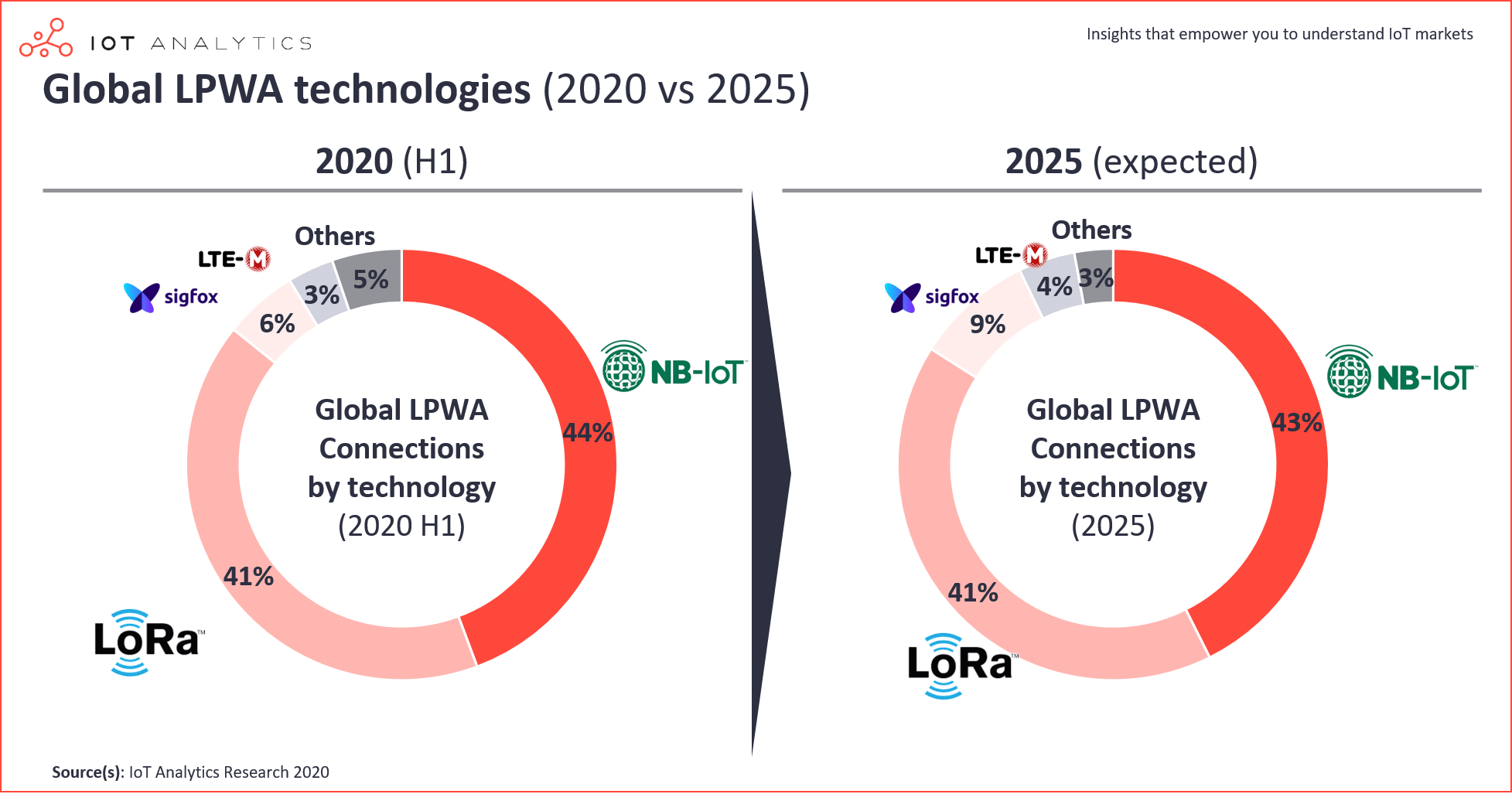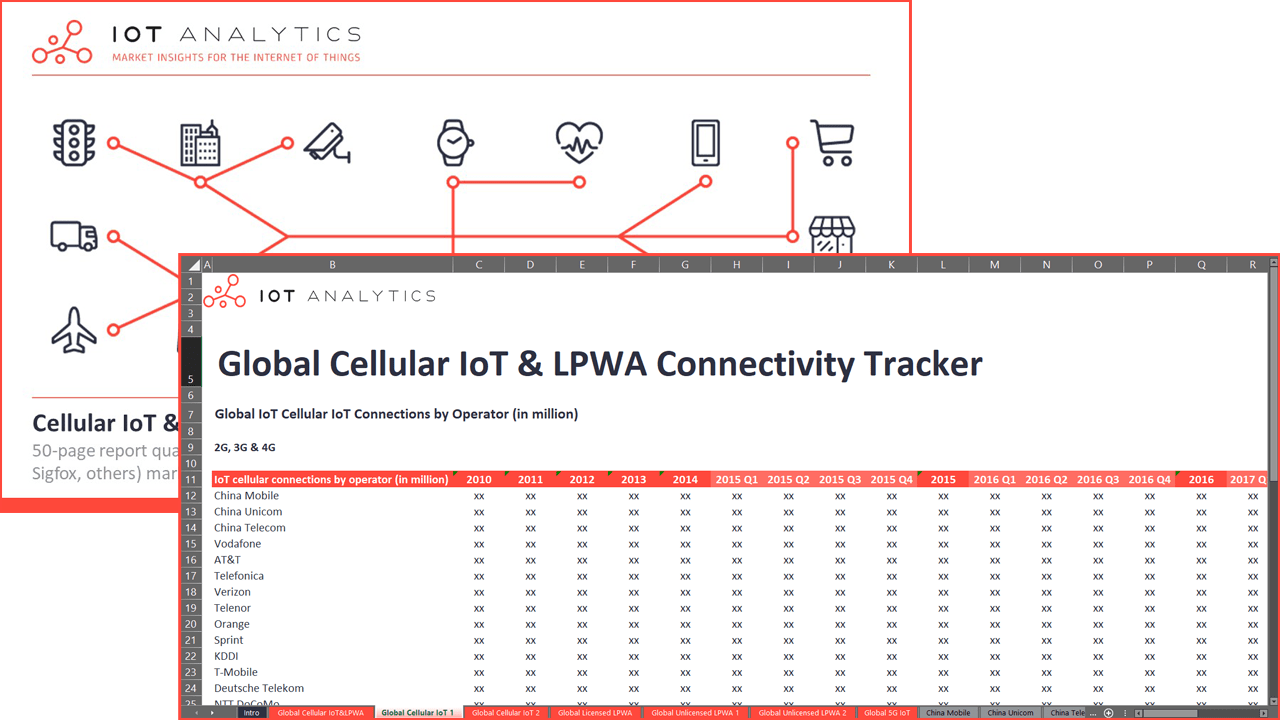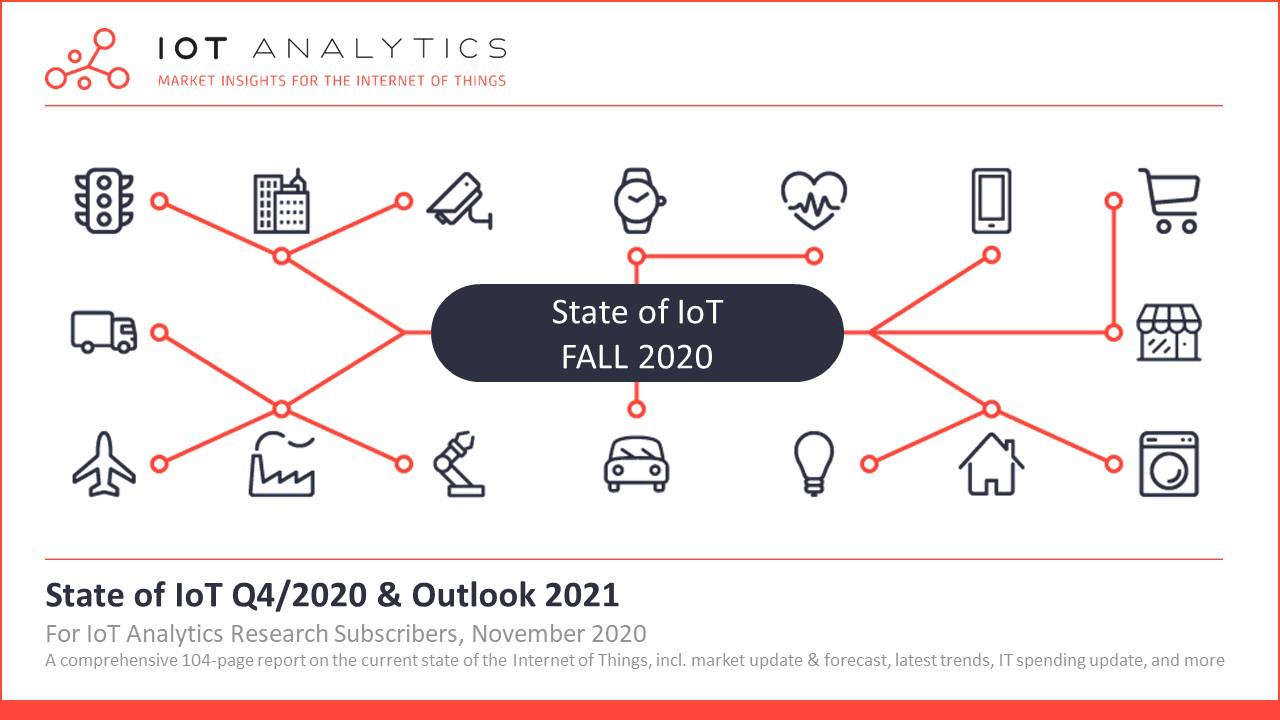Update September 2021: IoT Analytics published more recent blogs on: IoT technology market attractiveness: Where to invest going into 2022 and State of IoT 2021: Number of connected IoT devices growing 9% to 12.3 billion globally, cellular IoT now surpassing 2 billion.

Market Update
Despite the ongoing Covid-19 pandemic, the market for the Internet of Things continues to grow. In 2020, for the first time, there are more IoT connections (e.g., connected cars, smart home devices, connected industrial equipment) than there are non-IoT connections (smartphones, laptops, and computers). Of the 21.7 billion active connected devices worldwide, 11.7 billion (or 54%) will be IoT device connections at the end of 2020. By 2025, it is expected that there will be more than 30 billion IoT connections, almost 4 IoT devices per person on average.
This is one of many findings in IoT Analytics’ latest reports State of the IoT Q4 2020 & 2021 outlook as well as the updated Cellular IoT connectivity & LPWA Market Tracker 2010-2025 (Q4/2020 update).
Compared to an analysis performed in mid-2018, IoT Analytics has now raised its forecast for the number of connected IoT devices in 2025 (from 21.5 billion to 30.9 billion). Several factors are driving the growth, most notably:
- China. IoT has been booming in China at levels that seemed unimaginable a few years ago. While in 2015, for example, Chinese telecom companies accounted for roughly one quarter (27%) of all cellular IoT connections, this number has shot up to 75% in 2020 with China Telecom, China Unicom, and China Mobile leading the global cellular IoT connections market.
- Personal and home devices. The pervasive use of personal IoT devices such as fitness wearables further accelerated in the last 2 years and is expected to continue to do so. The introduction and subsequent adoption of a new generation of ecosystem-enabled smart home devices such as the Amazon Echo led to faster adoption of connected home devices than previously assumed.
- LPWA. Counting a mere 10 million connections in 2015, the global market for low-power wide-area (LPWA) connectivity was quasi non-existent 5 years ago. LPWA enables IoT connections for remote battery-powered devices such as smart meters, containers in logistics, or critical infrastructure like fire hydrants in cities. In 2020 this market reached 423 million IoT connections and is expected to grow at a CAGR of 43% to reach 2.5 billion IoT connections by 2025.
Going forward, IoT devices are expected to continue to grow much faster than the quasi-saturated market of non-IoT devices. The current forecast is that there will be 30.9 billion connected IoT devices by 2025 further driven by new technology standards like 5G.

The Cellular IoT & LPWA market
Both cellular IoT (2G, 3G, 4G, and now also 5G) as well as LPWA (NB-IoT, LTE-M, Lora, Sigfox, and others) have been key drivers of the global IoT connectivity market in the past 5 years. The number of active cellular IoT and LPWA connections grew at an annual rate of 43% between 2010 and 2019 and is expected to grow at a rate of 27% going forward, according to IoT Analytics’ new Cellular IoT & LPWA connectivity market tracker.
Cellular IoT
As discussed earlier in this article, China has moved to the forefront of cellular IoT connections. China Mobile, China Telecom, and China Unicom account for almost three-quarters of the market. In the past 12 months, China Mobile increased its market share by more than 5 percentage points. US-based AT&T lost one percentage point and now sits at 4% global market share in 2020. Apart from Vodafone, European-based providers do not make it in the top 5. The dominance of Chinese players can be largely attributed to the digital push by the Chinese government which views the adoption of cellular technologies (particularly 5G and NB-IoT) as a competitive asset in the quest to move the equilibrium of technological innovation from the US and Europe towards China.

LPWA market
The rise of low-power wide-area networks is one of the biggest and perhaps the most unexpected connectivity technology success story of the 2010 decade. In 2010 almost nobody had heard of LPWA, even 5 years later the market was so nascent that there were only a few providers with a few million total connections. In 2020, LPWA is enjoying strong momentum. Some people believe that by 2030, the number of LPWA IoT connections could outnumber that of any other IoT connectivity technology.

The picture in 2020 is that of a two-horse race. LoRa (and LoraWAN) technology, which is operating in the unlicensed spectrum and largely driven by the Lora Alliance, is in a head-to-head battle with NB-IoT, which is operating in the licensed spectrum and mostly driven by leading telecommunication firms around the world.
IoT Analytics expects that those two technologies will continue to dominate the market in the coming 5 years, with Sigfox and LTE-M in distant third and fourth places, respectively. While other technologies continue to exist, at this point it does not appear as though they would play a significant role in the overall global market.
More information and further reading
Are you interested in learning more about the cellular Internet of Things and the LPWA connectivity market?
The Cellular IoT & LPWA Connectivity Market Outlook 2020 – 2025 is a comprehensive market tracker quantifying the cellular IoT (2G, 3G, 4G, 5G) and LPWA (NB-IoT, LTE-M, Lora, Sigfox, others) market incl. data dating back to 2010 and forecasts until 2025 – November 2020. It is part of IoT Analytics’ ongoing coverage of IoT Connectivity.

This report provides answers to the following questions (among others):
- Number of active IoT connections worldwide
- Number of active IoT cellular connections and LPWA connections by technology (2G, 3G, 4G, 5G, NB-IoT, LTE-M, Lora, Sigfox, other LPWA)
- Number of active cellular IoT and LPWA connections by region and by selected countries
- Number of active cellular IoT connections by top 20 operators and technology
- Number of active unlicensed LPWA connections by industry
- Everything available for the timeframe 2010 – Q2 2020 with forecasts until 2025
- And more
Sample:
The sample of the market tracker gives you a holistic overview of the available data sets(Excel file with all tabs, columns and key slides from the report). The sample also provides additional context on the topic and describes the methodology of the analysis. You can download the sample here:
Are you interested in getting a broader picture and learn more about the current state of technology and the Internet of Things?

This report provides answers to the following questions (among others):
- Numerous insights on the current market environment, recent technology developments, latest IoT projects, and notable announcements
- IoT market update & outlook (global IoT connections, revenue, regional view)
- Survey data from 50 senior IT decision-makers (on current priorities, spending, and outlook)
- Covid-19 themes (incl. 21 IoT-related themes that are accelerating now)
- Tech stack analysis across 5 layers (IoT Hardware, Connectivity, Software/Platform/Cloud, Analytics/AI, IoT Security)
- Investment & M&A highlights
Sample:
The sample of the State of IoT report gives you a holistic overview of the entire report (including detailed table of contents and sample charts). The sample also provides additional context on the topic which is not provided in this article, reveals additional insights, and describes the methodology of the analysis. You can download the sample here:
Are you interested in continued IoT coverage and updates?
Subscribe to our newsletter and follow us on LinkedIn and Twitter to stay up-to-date on the latest trends shaping the IoT markets. For complete enterprise IoT coverage with access to all of IoT Analytics’ paid content & reports including dedicated analyst time check out Enterprise subscription.

